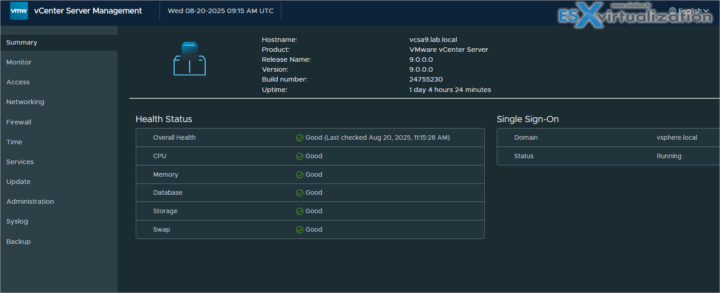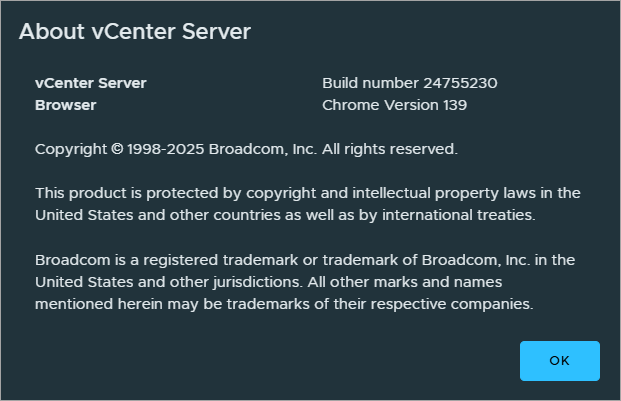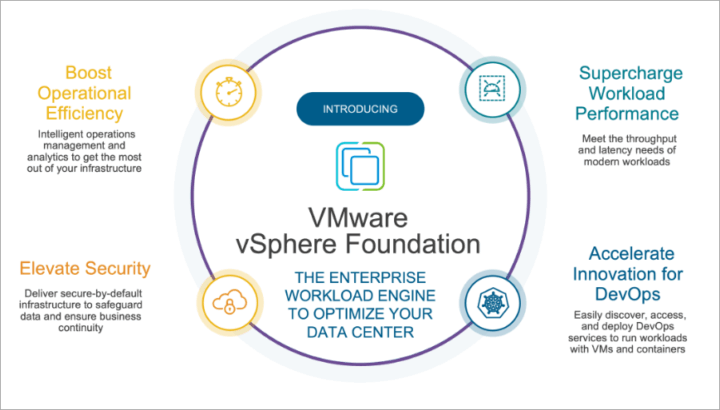Yes, I start the work again on a VCP Study Guide! I do hope our study guides for vSphere 7 and vSphere 8 has had help you in your studies or your carreer in the past! The idea is the same this time: Create a comprehensive study guide which helps you to pass VMware/Broadcom certification.
Welcome to the first in a series of blog posts designed to help you to pass the VMware Certified Professional – VMware vSphere Foundation Administrator (2V0-16.25) certification exam! The upcoming study guide page is here – VCP-VVF Administrator (for now, work-in-progress). We follow the official VMware Blueprint for the exam – VMware vSphere Foundation Administrator (PDF). Most of the work will be done here on this blog, and, in the end, the document will be released as a PDF, like the previous versions.
The exam is based on vSphere 9.x/ESXi 9.x product.
Language: English
Duration: 135 Minutes
Number of Questions: 60 (English)
Format: Multiple Choice, Multiple Choice Multiple Selection
Passing Score: 300
Pricing: $250
This post kicks off our series into the exam objectives, starting with Objective 2.1 – Virtualization Fundamentals – Identify the use case for Virtualization. Whether you’re an IT professional transitioning to cloud administration or a seasoned VMware admin looking to validate your skills, understanding the core principles of virtualization is the foundation of your vSphere journey. Let’s break down the sub-objectives – Describe the principles of Virtualization, Identify the use cases for Virtualization, and Identify the value proposition for Virtualization—and equip you with the knowledge and resources to succeed.
Why Virtualization Fundamentals Matter
1. Describe the Principles of Virtualization
What is Virtualization?
Key Principles of Virtualization:
- Abstraction: Virtualization abstracts physical hardware resources (CPU, memory, storage, networking) into virtual resources that VMs can use. For example, a VM “sees” virtual CPUs (vCPUs) and virtual memory, not the physical hardware directly.
- Isolation: Each VM operates independently, with its own operating system and applications, isolated from other VMs on the same host. This ensures that a crash in one VM doesn’t affect others.
- Encapsulation: A VM is encapsulated as a set of files (e.g., .vmx configuration file, .vmdk virtual disk files), making it portable and easy to back up or migrate.
- Resource Sharing: The hypervisor dynamically allocates physical resources among VMs, optimizing hardware utilization.
- Hardware Independence/Portability: VMs are decoupled from specific hardware, allowing them to run on any compatible host, which enhances flexibility and portability.
How It Works in vSphere:
Study Tip:
- Visualize the relationship between the physical host, ESXi hypervisor, and VMs. Use VMware’s Hands-On Labs (HOL) to explore ESXi and see how VMs are created and managed.
- Key Resource: VMware vSphere Documentation – Virtualization Basics.
Example image from vSphere 9 lab
2. Identify the Use Cases for Virtualization
Here are the most common ones:
- Server Consolidation: Instead of running one application per physical server (which often under System: underutilized hardware), virtualization allows multiple VMs to run on a single server, reducing the number of physical servers needed. This is ideal for data centers with limited space or budget.
- Test and Development Environments: Virtualization enables developers to create isolated, disposable VMs for testing software or configurations without risking production systems.
- Disaster Recovery and Business Continuity: VMs can be backed up, replicated, or migrated (e.g., using vMotion) to ensure uptime during hardware failures or disasters.
- Desktop Virtualization: VMware Horizon (built on vSphere) delivers virtual desktops, enabling remote work and centralized management of user environments.
- Legacy Application Support: Virtualization allows older applications to run on modern hardware by emulating legacy environments in VMs.
- Cloud Infrastructure: vSphere underpins private and hybrid cloud environments, enabling scalable, on-demand resource allocation.
Exam Focus:
- Practice: Set up a lab with VMware Workstation or ESXi to simulate use cases like server consolidation or VM migration.
Example vCenter About screen
3. Identify the Value Proposition for Virtualization
Here’s what to know:
- Cost Savings:
- Reduced Hardware Costs: Server consolidation decreases the need for physical servers, lowering capital expenses.
- Lower Operational Costs: Reduced power, cooling, and data center space requirements save money.
- Simplified Management: vCenter Server centralizes management, reducing administrative overhead.
- Increased Efficiency:
- Resource Utilization: Virtualization maximizes hardware usage by running multiple VMs on a single host, often achieving 70-80% utilization compared to 10-20% for non-virtualized servers.
- Dynamic Resource Allocation: Features like VMware DRS (Distributed Resource Scheduler) optimize resource distribution across VMs.
- Flexibility and Scalability:
- VMs can be quickly provisioned, cloned, or scaled to meet changing demands.
- vSphere supports hybrid cloud integration, allowing seamless workload migration to public clouds.
- Enhanced Resilience:
- Features like High Availability (HA) and Fault Tolerance ensure minimal downtime by automatically restarting or protecting VMs during host failures.
- Snapshots and backups simplify recovery from software issues.
- Security and Isolation:
- VM isolation prevents issues in one VM from affecting others.
- Features like VM encryption (covered in later objectives) enhance data security.
Exam Focus:
Study Tip:
- Create a table comparing the costs, efficiency, and scalability of virtualized vs. physical environments to solidify your understanding.
- Key Resource: VMware vSphere Foundation Overview for details on cost and efficiency benefits.
Practical Tips for Mastering Objective 2.1
- Hands-On Practice: Use VMware Hands-On Labs to create and manage VMs, exploring how virtualization abstracts and isolates resources. Try the “Introduction to vSphere” lab to see the principles in action.
- Study Resources:
- VMware vSphere Documentation: Virtualization Basics section Broadcom Docs.
- Free study guide references from my page https://www.vladan.fr/vcp-vvf-administrator/.
- Key Concepts to Memorize:
- The five principles of virtualization (abstraction, isolation, encapsulation, resource sharing, hardware independence).
- Major use cases: server consolidation, disaster recovery, test/dev, cloud infrastructure.
- Value propositions: cost savings, efficiency, flexibility, resilience, security.
Sample Exam Questions (To give you an idea).
- What is a key principle of virtualization that ensures a VM’s failure does not impact other VMs on the same host?
Answer: Isolation.
Explanation: Isolation ensures each VM operates independently, preventing crashes or issues in one VM from affecting others. - A company wants to reduce data center costs by consolidating ten underutilized physical servers. Which virtualization use case best addresses this need?
Answer: Server consolidation.
Explanation: Virtualization allows multiple VMs to run on a single host, reducing the number of physical servers and associated costs. - What is a primary value proposition of virtualization for disaster recovery?
Answer: Enhanced resilience.
Explanation: Features like vSphere HA and VM snapshots enable rapid recovery from hardware or software failures.
Find other chapters on the main page of the guide – VCP-VVF Administrator Study Guide Page.
More posts from ESX Virtualization:
- Proxmox 9 (BETA 1) is out – What’s new?
- Another VMware Alternative Called Harvester – How does it compare to VMware?
- VMware vSphere 9 Standard and Enterprise Plus – Not Anymore?
- VMware vSphere Foundation (VVF 9) and VMware Cloud Foundation (VCF 9) Has been Released
- Vulnerability in your VMs – VMware Tools Update
- VMware ESXi FREE is FREE again!
- No more FREE licenses of VMware vSphere for vExperts – What’s your options?
- VMware Workstation 17.6.2 Pro does not require any license anymore (FREE)
- Migration from VMware to another virtualization platform with Veeam Backup and Replication
- Two New VMware Certified Professional Certifications for VMware administrators: VCP-VVF and VCP-VCF
- Patching ESXi Without Reboot – ESXi Live Patch – Yes, since ESXi 8.0 U3
- Update ESXi Host to the latest ESXi 8.0U3b without vCenter
- Upgrade your VMware VCSA to the latest VCSA 8 U3b – latest security patches and bug fixes
- VMware vSphere 8.0 U2 Released – ESXi 8.0 U2 and VCSA 8.0 U2 How to update
- What’s the purpose of those 17 virtual hard disks within VMware vCenter Server Appliance (VCSA) 8.0?
- VMware vSphere 8 Update 2 New Upgrade Process for vCenter Server details
- VMware vSAN 8 Update 2 with many enhancements announced during VMware Explore
- What’s New in VMware Virtual Hardware v21 and vSphere 8 Update 2?
- Homelab v 8.0
- vSphere 8.0 Page
- Upgrade VMware ESXi to 7.0 U3 via command line
- VMware vCenter Server 7.0 U3e released – another maintenance release fixing vSphere with Tanzu
- What is The Difference between VMware vSphere, ESXi and vCenter
- How to Configure VMware High Availability (HA) Cluster
Stay tuned through RSS, and social media channels (Twitter, FB, YouTube)





Leave a Reply